Key Highlights
- 3I-ATLAS discovery represents humanity’s third confirmed interstellar visitor, with record-breaking eccentricity and unique spectral properties
- Historical impact events like Tunguska (1908) and Chelyabinsk (2013) demonstrate catastrophic potential of asteroid strikes on populated areas
- NASA’s DART mission successfully proved asteroid deflection technology, though complex debris dynamics reveal greater mission planning challenges
- Legal governance gaps in the 1967 Outer Space Treaty create ambiguity around planetary defense responsibilities and international coordination
- India’s growing capabilities through ISRO’s NETRA system and international partnerships position it as an emerging leader in planetary defense
The discovery of 3I-ATLAS in July 2025 marks humanity’s third confirmed encounter with an interstellar visitor, following the enigmatic ʻOumuamua (2017) and 2I/Borisov (2019). With its record-setting eccentricity of 6.14 and approach velocity of 58 km/s, this cosmic wanderer has reignited discussions about planetary defense capabilities and the urgent need for international cooperation in protecting Earth from celestial threats. arxiv
Definition and Significance
Interstellar objects are celestial bodies that originate from outside our Solar System, traveling through interstellar space on hyperbolic trajectories that carry them past our Sun before continuing their journey through the galaxy. These visitors provide unprecedented insights into the formation processes of other star systems and the chemical composition of distant planetary environments. phys
3I-ATLAS Discovery Details:
- Discovered by ATLAS survey on July 1, 2025
- Located 4.5 AU from the Sun at discovery
- Record eccentricity of 6.14 surpassing both predecessors
- Perihelion approach on October 29, 2025, at 1.356 AU from the Sun
Divergent Characteristics of Interstellar Visitors
The three confirmed interstellar objects display remarkably different properties, challenging our understanding of these cosmic visitors:
ʻOumuamua (1I/2017 U1):
- Asteroid-like appearance with no visible coma
- Extreme elongation with 10:1 length-to-width ratio
- Non-gravitational acceleration detected at 30-sigma confidence
- Tumbling rotation with 7.3-hour period science.nasa
2I/Borisov:
- Typical comet behavior with visible gas and dust emission
- CN gas detection at 2.7 AU from the Sun
- Nucleus fragmentation observed in March 2020
- Composition similar to Oort Cloud comets iopscience.iop
3I-ATLAS:
- Early coma formation without detectable gas emission
- Flat light curve with <0.2 magnitude variation over 29 hours
- Red continuum spectrum similar to extreme trans-Neptunian objects
- Complex carbonaceous composition indicated by spectral analysis
Historical Impact Events: Lessons from Earth’s Past
The Tunguska Event (1908)
The Tunguska explosion remains the most devastating recorded asteroid impact, demonstrating the catastrophic potential of celestial collisions: britannica
Impact Characteristics:
- Date: June 30, 1908, at 7:14 AM local time
- Energy: 10-30 megatons TNT equivalent (1,000 times Hiroshima bomb)
- Altitude: 5-10 km airburst explosion
- Damage: 2,150 km² of forest flattened, 100 km² charred
Object Properties:
- Estimated size: 50-80 meters diameter
- Composition: Likely stony asteroid
- Speed: Approximately 27 km/s (Mach 80)
- Approach: From east-southeast direction
The Chelyabinsk Meteor (2013)
The Chelyabinsk event provided modern scientific data on asteroid airbursts and their urban impact potential: pnas
Event Details:
- Date: February 15, 2013, at 9:20 AM local time
- Object size: 17-20 meters diameter, 7,000-10,000 tons
- Energy: 400-500 kilotons TNT equivalent
- Casualties: Over 1,600 injured, no fatalities
Damage Assessment:
- 7,200 buildings damaged including schools, hospitals, and residences
- Economic impact: Over $33 million in property damage
- 100,000 home-owners affected by broken windows
- Demonstrated that meteor airbursts cause more damage than equivalent nuclear explosions
NASA’s DART Mission: Proving Planetary Defense Technology
Successful Asteroid Deflection Demonstration
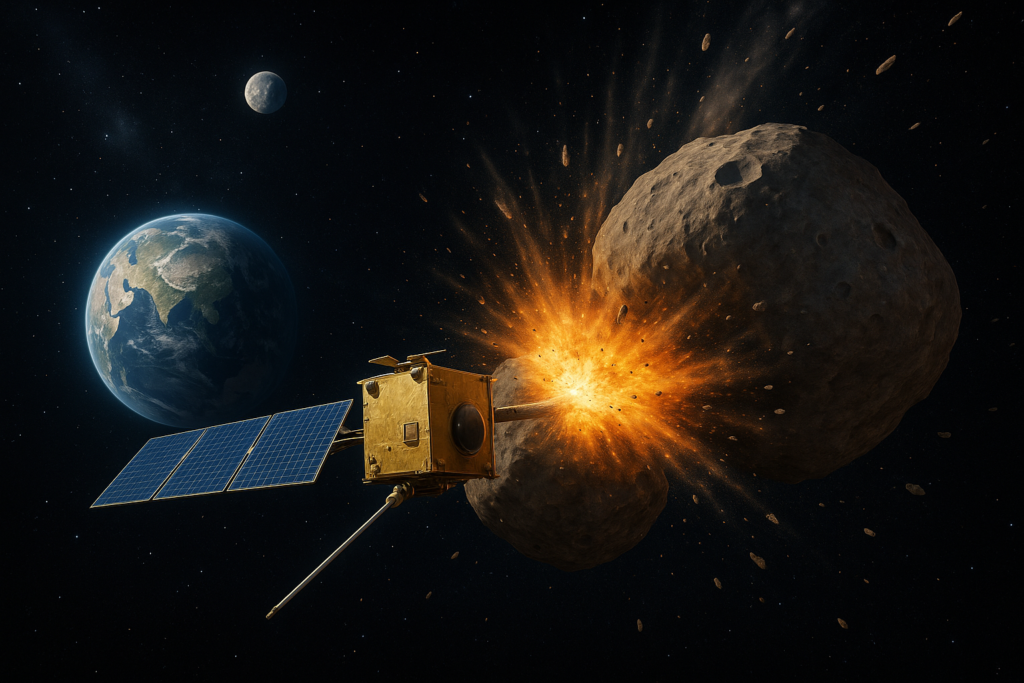
NASA’s Double Asteroid Redirection Test (DART) achieved a historic milestone in September 2022, successfully altering an asteroid’s orbit for the first time in human history: science.nasa
Mission Achievements:
- Target: Dimorphos asteroid (530 feet diameter) nasa
- Impact velocity: 14,000 mph (22,530 km/h)
- Orbital change: 32 minutes reduction (exceeded 73-second minimum goal by 25x)
- Mission duration: 10 months from launch to impact
Complex Physics of Asteroid Deflection
Recent analysis reveals that asteroid deflection involves more complex physics than initially understood: sciencedaily
Key Discoveries:
- Boulder ejection carried three times more momentum than the spacecraft impact
- Unexpected debris directions complicate future mission planning
- Recoil effects from ejected material substantially enhanced deflection
- Force multiplication through debris ejection validates kinetic impactor concept
India’s Growing Role in Planetary Defense
ISRO’s Space Surveillance Capabilities
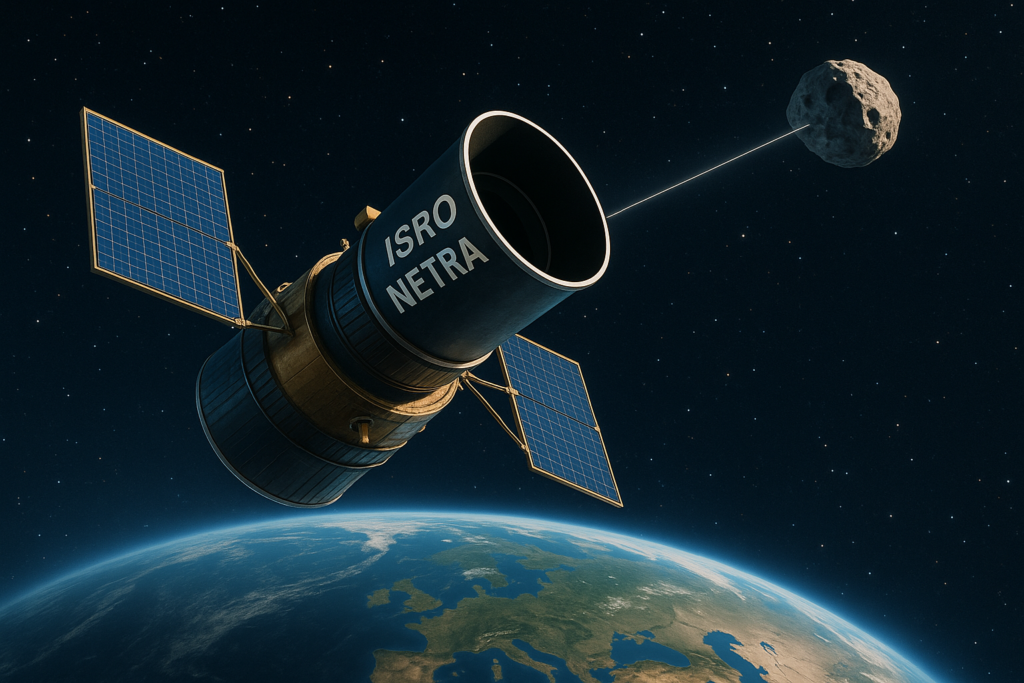
India has emerged as a significant player in planetary defense through ISRO’s expanding capabilities and international collaborations: iadb
NETRA System Capabilities:
- Network for Space Objects Tracking and Analysis operational
- Radar and optical telescopes for asteroid detection
- Apophis monitoring for 2029 close approach
- Space Situational Awareness comparable to US and Russia
International Collaboration Framework
US-India Space Partnership:
- Minor Planet Center participation approved for Indian institutions
- Asteroid detection and tracking collaboration through Smithsonian Astrophysical Observatory
- Joint crewed missions to ISS under discussion
- QUAD partnership implications for Indo-Pacific space security
ISRO’s Technical Achievements:
- Chandrayaan-3 lunar landing success
- Aditya-L1 solar observatory mission
- Precision spacecraft navigation capabilities demonstrated
- Complex orbital maneuvers expertise for asteroid missions
India’s Asteroid Mission Aspirations
ISRO Chairman S. Somanath has expressed India’s readiness for asteroid research collaborations, specifically mentioning:
- Apophis mission support for 2029 approach
- Instrument contributions to international missions
- Collaborative partnerships with NASA, ESA, and JAXA
- Indigenous capabilities in spacecraft navigation and capture
Legal and Governance Framework Gaps
Outer Space Treaty Limitations
The 1967 Outer Space Treaty provides limited guidance for planetary defense, creating significant governance gaps: diplomacyandlaw
Critical Gaps:
- No explicit planetary defense provisions mentioned
- Peaceful purposes clause creates ambiguity for defensive weapons
- State responsibility unclear for international defense missions
- No enforcement mechanisms for treaty violations ijirl
UN COPUOS and International Cooperation
The United Nations Committee on the Peaceful Uses of Outer Space (COPUOS) serves as the primary forum for space governance, but lacks dedicated planetary defense authority: cosparhq
Current Structure:
- 102 Member States and 45 Observer Organizations
- Scientific and Technical Subcommittee addresses technical issues
- Legal Subcommittee handles governance frameworks
- COSPAR observer status since 1962 provides scientific input
Planetary Defense Initiatives:
- Space Mission Planning Advisory Group (SMPAG) coordinates response activities
- International Asteroid Warning Network (IAWN) facilitates information sharing
- 19 Members and 6 Observers including ESA as current chair
The Responsibility to Defend Earth Framework
Emerging Normative Principles
Recent scholarship proposes the “Responsibility to Defend Earth” (R2DE) as a core principle for planetary defense governance: pmc.ncbi.nlm
Three-Pillar Framework:
- Responsibility to Detect: Early warning systems and space surveillance
- Responsibility to Deflect: Technical capabilities for threat mitigation
- Responsibility to Prepare: Comprehensive disaster preparedness and recovery
Multilateral Principles:
- Diffuse reciprocity: Countries deploy capabilities regardless of contribution capacity
- Indivisibility: Equal security guarantee for all members
- Common heritage: Shared responsibility for Earth’s protection
Technological and Strategic Challenges
Detection and Warning Time Limitations
Interstellar objects present unique detection challenges that expose current system limitations:
Technical Challenges:
- High-speed trajectories (50-60 km/s) reduce warning time
- Small sizes difficult to detect at distance
- Unpredictable paths complicate tracking
- Limited telescope coverage creates detection gaps
Future Detection Systems:
- Vera C. Rubin Observatory expected to increase ISO detections dramatically
- Space-based observation constellations proposed for comprehensive coverage
- AI-enhanced detection algorithms for rapid identification
- International coordination essential for global coverage
Deflection Technology Development
Current deflection technologies remain experimental and limited, requiring significant development:
Technology Gaps:
- Kinetic impactors effective but complex physics involved
- Nuclear deflection technically feasible but politically sensitive
- Gravity tractors suitable for long-term missions only
- Ion beam shepherding requires advanced propulsion systems
The Path Forward: Building Global Defense Architecture
Technological Development Priorities
Enhanced Detection Systems:
- Space-based telescope networks for comprehensive sky coverage
- AI and machine learning algorithms for rapid object classification
- International data sharing protocols for real-time threat assessment
- Ground-based radar networks for precise trajectory determination
Advanced Deflection Technologies:
- Multiple kinetic impactor missions for larger threats
- Nuclear pulse propulsion for extreme emergency scenarios
- Solar sail deflection for long-term orbital modifications
- Ion beam shepherding for precise trajectory adjustments
International Governance Framework
UN Planetary Defense Council:
- Dedicated UN body with authority to coordinate global response
- Rapid decision-making mechanisms for emergency situations
- Resource pooling arrangements among member nations
- Technology sharing agreements for common defense
Legal Framework Updates:
- Planetary Defense Protocol to supplement Outer Space Treaty
- Clear mandate for defensive space activities
- Liability frameworks for international defense missions
- Verification mechanisms for compliance monitoring
India’s Strategic Opportunities
Indigenous Capability Development:
- Atmanirbhar Bharat principles applied to space defense technology
- Dual-use technologies serving both civilian and defense purposes
- Public-private partnerships through IN-SPACe framework
- Regional leadership in South Asian space cooperation
International Leadership Role:
- UN forum advocacy for planetary defense protocols
- Technology transfer agreements with developing nations
- Capacity building programs for emerging space nations
- Disaster preparedness integration with climate change adaptation
The emergence of interstellar objects like 3I-ATLAS serves as a reminder that Earth exists in a dynamic cosmic environment where threats can arrive with little warning. While these particular visitors pose no direct impact risk, they highlight the urgent need for comprehensive planetary defense capabilities and international cooperation frameworks.
As we advance into an era where space technology democratization enables more nations to contribute to planetary defense, the challenge becomes not just technical but also diplomatic and legal. The success of missions like DART proves that humanity possesses the basic technology to deflect asteroids, but scaling these capabilities to address larger threats requires unprecedented global cooperation.
India’s growing space capabilities, combined with its diplomatic tradition of non-alignment and commitment to global public goods, position it uniquely to lead efforts in establishing inclusive planetary defense governance. The time for action is now, before we face a real threat that tests our collective preparedness and resolve.
Mains Practice Qs
GS-II (IR / Governance):
- “Planetary defense is no longer a science-fiction concept but a governance necessity.” Critically analyze with reference to interstellar objects like 3I-ATLAS.
GS-III (Science & Tech):
- Discuss the challenges and opportunities for India in contributing to global planetary defense efforts.
Essay Angle:
- “Preparedness is the best form of defense: Lessons from the cosmos.”
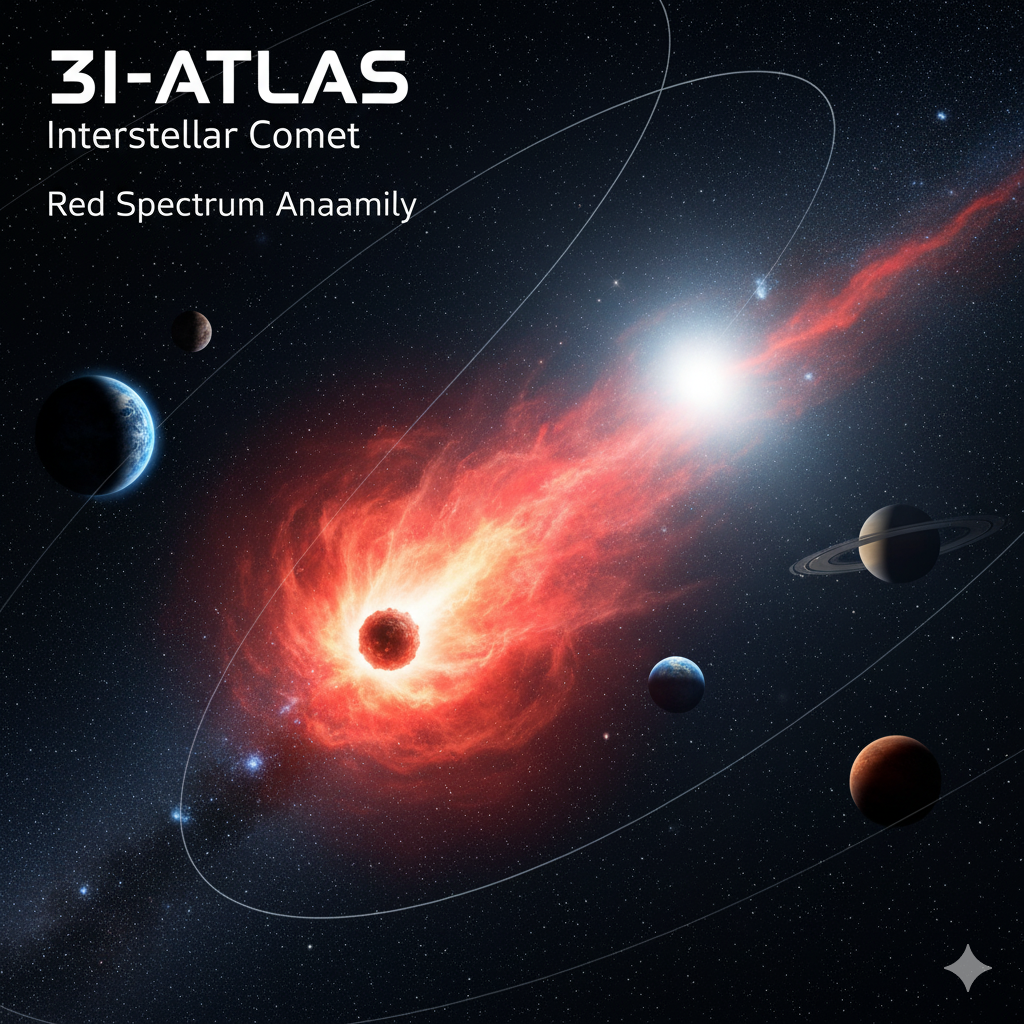
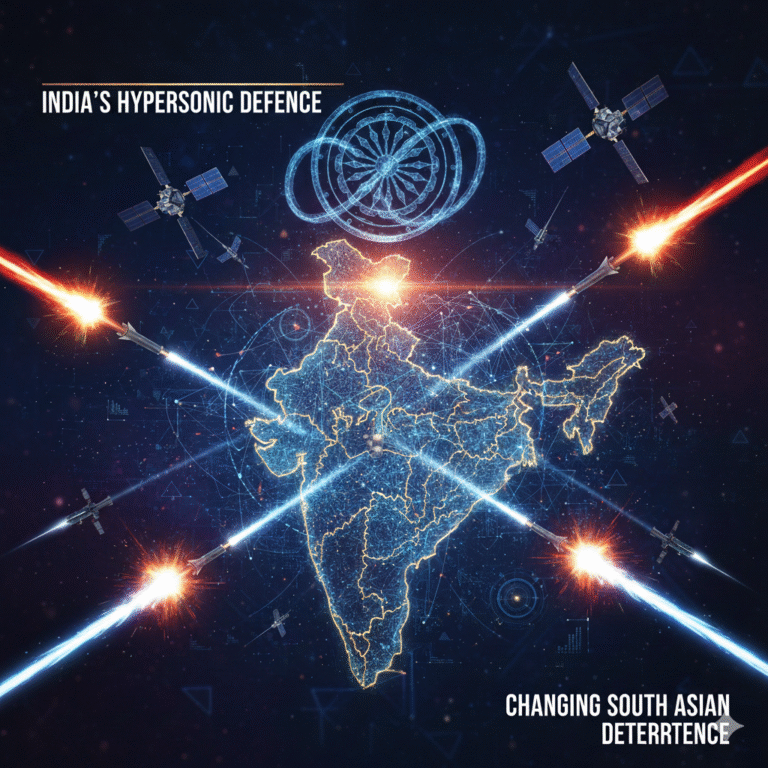
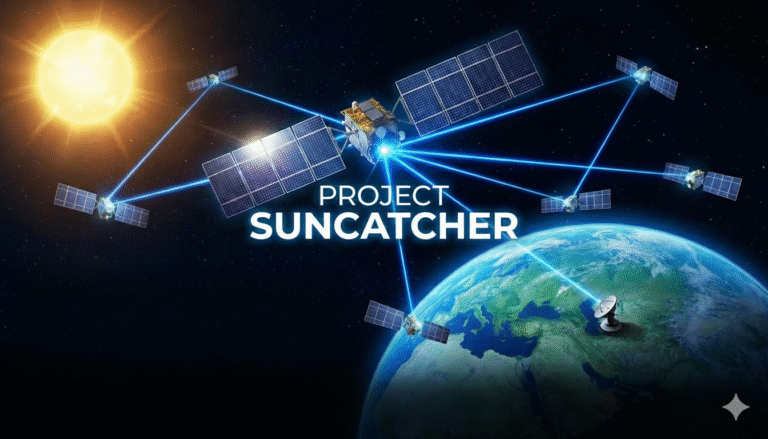






+ There are no comments
Add yours